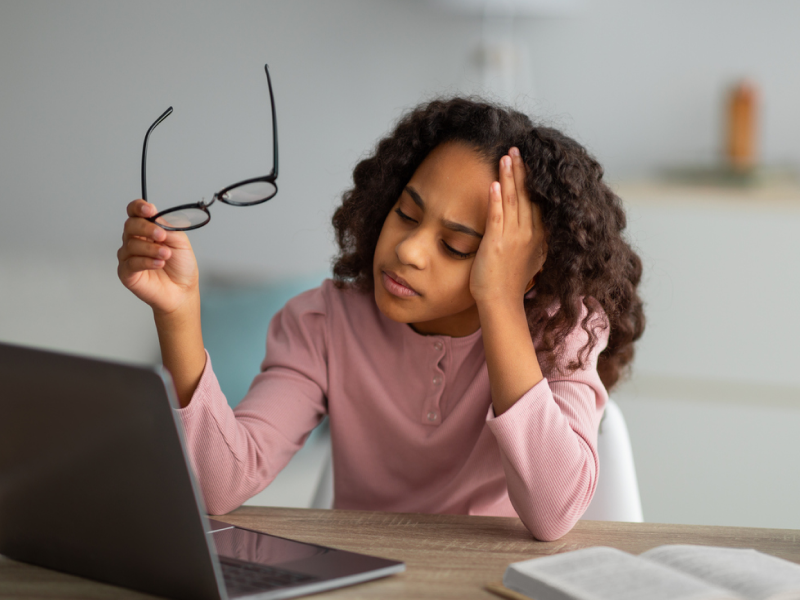
Table of Contents
The Connection Between Anxiety Disorders and Migraines
Written By: Charlie Health Editorial Team

Clinically Reviewed By: Dr. Don Gasparini
August 7, 2023
6 min.
Not everyone with migraines will develop anxiety, but studies show an increased risk of anxiety in people with chronic or frequent migraines. Learn more about the link between migraines and anxiety here.
Learn more about our Clinical Review Process
Table of Contents
What is the link between migraines and anxiety?
The link between migraine and anxiety is complex and bidirectional, meaning many people with migraines also suffer from anxiety, and conversely, individuals with anxiety disorders may be more prone to experiencing migraines. Studies have shown that individuals with migraine headaches are more likely to have anxiety disorders, such as generalized anxiety disorder, panic disorder, or social anxiety disorder. Here are some key factors that contribute to the link between migraine and anxiety:
Shared neurobiological pathways
Both migraines and anxiety involve alterations in the brain’s neurobiological pathways. Serotonin, a neurotransmitter that regulates mood, pain, and other functions, is implicated in both conditions. Changes in serotonin levels can contribute to the development of both migraines and anxiety.
Triggers
Migraine attacks can be triggered or exacerbated by stress and anxiety. Emotional stress, including anxiety, is a common trigger for migraines in many individuals. The release of stress hormones during periods of anxiety can lead to physiological changes that increase the likelihood of migraine onset.

Are you struggling to manage your mental health?
Chronic pain can take a serious toll. We can help.
Pain perception
Anxiety can influence the perception of pain, making migraines potentially feel more intense and distressing for those who experience anxiety. This may lead to a cycle where anxiety worsens migraine symptoms, and in turn, migraine-related pain increases anxiety levels.
Lifestyle factors
Anxiety can impact an individual’s lifestyle choices, leading to irregular sleeping patterns, poor dietary habits, and increased caffeine consumption—all common triggers for migraines.. These lifestyle factors can, in turn, influence the frequency and severity of migraines.
Psychological impact
Frequent migraines can take a toll on an individual’s mental health, leading to increased levels of anxiety, depression, and overall psychological distress. The burden of dealing with chronic pain and the uncertainty of when the next migraine attack will occur can contribute to anxiety symptoms.
Do migraines cause anxiety or the other way around?
The relationship between migraines and anxiety is bidirectional, with each condition potentially influencing and exacerbating the other. This bidirectional relationship makes it hard to say if migraines cause anxiety, or vice versa, and the answer likely differs from person to person.
On one hand, migraines can lead to increased anxiety, since they cause distress and impairment. Specifically, the pain, sensitivity to light and sound, and nausea caused by migraines can contribute to anxiety symptoms. On the other hand, chronic anxiety, such as generalized anxiety disorder (GAD), can trigger migraines. Emotional stress and tension associated with anxiety can lead to physiological changes, making a person more susceptible to migraines or worsening their frequency and severity. Both conditions share neurobiological factors, including imbalances in neurotransmitters like serotonin. Additionally, lifestyle factors related to anxiety, such as disrupted sleep patterns and poor diet, can worsen migraine headache symptoms.
Understanding the complex relationship between migraines and anxiety is crucial in developing effective treatment strategies that address both conditions. If you experience co-occurring migraines and anxiety, seeking professional medical evaluation can help create a personalized plan for managing symptoms and improving your overall well-being.
Migraine-anxiety related dizziness (MARD)
Migraine-anxiety-related dizziness (MARD), or vestibular migraine with comorbid anxiety, is a condition where people experience both migraines with vestibular symptoms, including dizziness. MARD is at the intersection of two distinct conditions: vestibular migraines and anxiety-related dizziness.
Vestibular migraine is a subtype of migraine whose primary symptom is vertigo or dizziness. Along with typical migraine symptoms, such as severe headaches, individuals with vestibular migraines experience episodes of dizziness, imbalance, and spatial orientation issues. These symptoms are often associated with or occur before, during, or after a migraine attack. Vestibular migraines are thought to arise from the same underlying causes as traditional migraines but involve the vestibular system, which maintains balance and spatial orientation.
Anxiety-related dizziness is dizziness or lightheadedness that occurs due to anxiety or a panic attack. During times of heightened anxiety or stress, the body may release stress hormones, leading to physiological changes that can cause dizziness or a feeling of being lightheaded. When a person experiences anxiety-related dizziness, they may feel unsteady or like the world is spinning, similar to the sensations reported in vestibular migraines.
Situated at the intersection between vestibular migraines and anxiety-related dizziness, MARD can be a complex condition. As mentioned earlier, stress and anxiety can trigger migraines, and for individuals with vestibular migraines, anxiety can worsen the dizziness symptoms during an attack. Conversely, the unpredictability and distress caused by vestibular migraines can lead to increased anxiety, creating a cycle where each condition exacerbates the other.
The management of MARD often involves addressing both the migraine and anxiety components. Identifying triggers, understanding the condition, and avoiding stressors can help manage MARD. Depending on the severity and frequency of symptoms, medications may be prescribed to manage migraines and anxiety. Preventive medications for migraines and anti-anxiety medications may be considered. Adopting a healthy lifestyle with regular exercise, proper sleep, and stress-reducing techniques can also help manage both conditions.

How to manage migraine headaches and anxiety
Managing migraine headaches and anxiety requires a comprehensive approach that addresses both conditions simultaneously. This may include a combination of pharmacological treatments for migraines and anxiety disorders, behavioral therapies, stress management techniques, and lifestyle adjustments to minimize triggers. If you or someone you know is dealing with migraines and anxiety, it’s essential to seek professional medical advice for proper evaluation and personalized treatment. Here are some strategies that may help:
1. Seek professional guidance
Consult with a healthcare provider, such as a neurologist or a mental health professional, for a proper diagnosis and personalized treatment plan. They can help determine the severity of your migraines and anxiety and recommend appropriate interventions.
2. Medication
There are medications available for managing both migraines and anxiety. Preventative medications may be prescribed to reduce the frequency and severity of migraine attacks. Acute medications can also be used to treat individual migraine episodes. Antidepressants or anti-anxiety medications may be prescribed to manage anxiety symptoms.
3. Identify triggers
Keep a headache and anxiety diary to track potential triggers for both conditions. Common migraine triggers include stress, certain foods, hormonal changes, and lack of sleep. Identifying triggers can help you avoid or manage them effectively.
4. Stress management
Adopt stress-reduction techniques to manage anxiety and lower the likelihood of chronic migraine attacks. Practices such as mindfulness meditation, deep breathing exercises, yoga, and progressive muscle relaxation can be beneficial.
5. Regular exercise
Engage in regular physical activity as it can help alleviate anxiety and may reduce the frequency of migraines. Choose activities that you enjoy and can incorporate into your routine.
6. Sleep hygiene
Establish a consistent sleep schedule and practice good sleep hygiene to improve the quality and quantity of your sleep. Lack of sleep can trigger both migraines and anxiety.
7. Healthy diet
Maintain a balanced diet and try to identify any specific food triggers for migraines. Limiting caffeine and alcohol intake can also be helpful.
8. Cognitive behavioral therapy (CBT)
CBT is an effective therapeutic approach for managing anxiety. It can help identify negative thought patterns and develop coping strategies to reduce anxiety levels.
9. Relaxation techniques
In addition to stress management practices, other relaxation techniques such as biofeedback and aromatherapy may be helpful in managing both conditions.
10. Support system
Reach out to friends, family, or support groups to share your experiences and feelings. Having a support system can provide comfort and understanding during difficult times.
Remember that everyone’s experience with migraines and anxiety is unique, so it’s essential to tailor your management plan to suit your needs. Be patient and give each strategy sufficient time to show its effectiveness.
Treating anxiety with Charlie Health
Your life does not need to be ruled by anxious thoughts and feelings. Whether you’re experiencing occasional anxiety or living with intense anxiety symptoms, seeking professional help is imperative, since anxiety disorders do not usually go away on their own.
The trained professionals at Charlie Health are here to help you address your mental health challenges and manage anxiety. For people with anxiety disorders, learning how to challenge thought processes and modify behavior in a healthy way can make the experience of anxiety less overwhelming and help manage anxiety symptoms, including anxiety-induced migraines. Charlie Health’s virtual intensive outpatient program (IOP) offers a combination of individual therapy, supported groups, and family therapy to comprehensively and effectively treat people struggling with anxiety and other mental health conditions. Click here to fill out a brief form and start your journey today.




